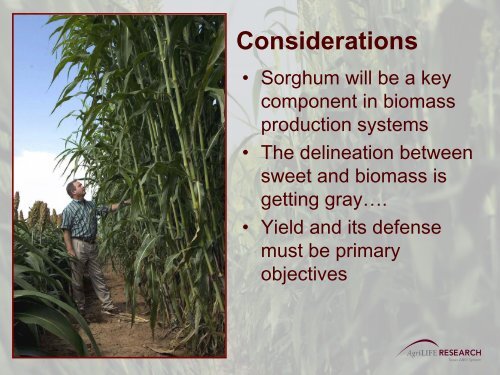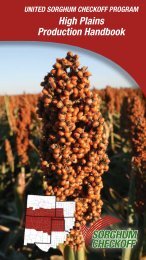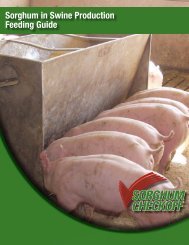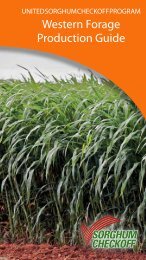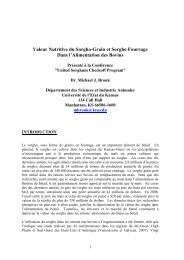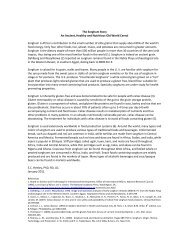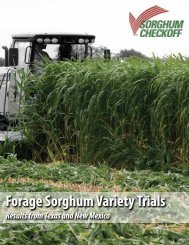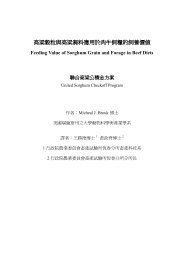Breeding sorghum for renewables â Dr. Bill Rooney, Texas A&M ...
Breeding sorghum for renewables â Dr. Bill Rooney, Texas A&M ...
Breeding sorghum for renewables â Dr. Bill Rooney, Texas A&M ...
You also want an ePaper? Increase the reach of your titles
YUMPU automatically turns print PDFs into web optimized ePapers that Google loves.
Considerations<br />
• Sorghum will be a key<br />
component in biomass<br />
production systems<br />
• The delineation between<br />
sweet and biomass is<br />
getting gray….<br />
• Yield and its defense<br />
must be primary<br />
objectives
Presentation Outline<br />
• Types of Sorghum/Considerations<br />
– Grain Sorghum<br />
– Sweet Sorghum<br />
– Biomass Sorghum<br />
• Composition<br />
• Interspersed with opinions on<br />
logistics, economics and items of a<br />
practical nature
Bioenergy Sorghum<br />
Biomass Sorghum<br />
Sweet<br />
Sorghum<br />
Grain Sorghum
Grain Sorghum<br />
• Utilizes the same conversion processes<br />
as <strong>for</strong> corn (starch to ethanol)<br />
• Breed <strong>for</strong> Grain Yield<br />
• Conversion efficiencies could be<br />
improved through selection of unique<br />
endosperm types<br />
– Waxy<br />
– High Protein Digestability
Sweet Sorghum<br />
• Lower Grain Yield<br />
• Juicy Stalk<br />
• Highest concentrations of soluble<br />
sugar<br />
• Highly variable <strong>for</strong><br />
– Maturities (photoperiod sensitivity)<br />
– Types of Sugar<br />
– Biomass and Sugar Yield
Sugar Yield is a function of both<br />
concentration and volume<br />
juice (lbs/acre)<br />
Sugar Content (g/100ml)<br />
40000.0<br />
35000.0<br />
30000.0 r 2 =.01<br />
25000.0<br />
20000.0<br />
15000.0<br />
10000.0<br />
5000.0<br />
0.0<br />
0.0 50.0 100.0 150.0 200.0 250.0 300.0<br />
ethanol (gallons/acre)<br />
18.0<br />
16.0<br />
14.0<br />
12.0<br />
10.0<br />
8.0<br />
6.0<br />
4.0<br />
r 2 =.66<br />
Sugar Yield (lbs/acre)<br />
3500.0<br />
3000.0<br />
2500.0<br />
2000.0<br />
1500.0<br />
r 2 =.96<br />
1000.0<br />
500.0<br />
0.0<br />
0.0 50.0 100.0 150.0 200.0 250.0 300.0<br />
Ethanol Yield (gallon/acre)<br />
2.0<br />
0.0<br />
0.0 50.0 100.0 150.0 200.0 250.0 300.0<br />
Ethanol (gallons/acre)
Juice Composition<br />
160<br />
140<br />
120<br />
Fructose<br />
Glucose<br />
Sucrose<br />
Sugar (g/L)<br />
100<br />
80<br />
60<br />
40<br />
20<br />
0
Sweet Sorghum<br />
• Cultivars<br />
– Traditional sweet <strong>sorghum</strong>s<br />
• Commercial scale production requires<br />
development of sweet <strong>sorghum</strong> hybrids<br />
– Increased seed yield, easier harvest<br />
– Capture heterosis <strong>for</strong> biomass, sugar and<br />
grain yield
Sweet Sorghum<br />
Hybrids<br />
• Higher Seed<br />
Yield<br />
• Mechanical<br />
Harvest<br />
• Height and<br />
Maturity<br />
Manipulation<br />
• High sugar yields<br />
• High brix
Sweet Sorghum Testing<br />
High Parent Heterosis (Corn, 2009)<br />
Trait mean range<br />
----------------- % -----------------<br />
Fresh Weight 27.4 -17 to 136<br />
Juice Weight 27.1 -20 to 129<br />
Brix -4.6 -15 to 13<br />
Sugar Yield 24.2 -22 to 127<br />
Plant Height 7.5 1 to 23<br />
High Parent (HP) Heterosis (%) = (F1 hybrid – HP)/HP * 100
Sweet Sorghum <strong>Breeding</strong><br />
• Seed Parents<br />
– Short Stature<br />
– Acceptable seed<br />
yield<br />
– High brix and juicy<br />
stalk<br />
• Pollinator Parent<br />
– Complementary<br />
Height and maturity<br />
– Juicy stalk and<br />
hHigh brix<br />
• Either or both<br />
– Disease<br />
Resistance<br />
– <strong>Dr</strong>ought<br />
Tolerance<br />
– Lodging<br />
resistance<br />
– Heterosis
Sweet Sorghum Maturity is Critical<br />
• Sugars are not shelf stable ….<br />
• Requires long harvest windows<br />
• Long harvest windows require<br />
– differential maturities in sweet <strong>sorghum</strong><br />
– planting and harvest plan to depoy them around<br />
a mill.<br />
• Photoperiod sensitivity influences<br />
– Days to maturity<br />
• Maturity influences<br />
– Yield and ratoon potential
Photoperiod Sensitivity/Insensitivity<br />
• In PI, reproductive growth is initiated without the<br />
influence of daylength<br />
• In PS, reproductive growth is initiated based on<br />
defined changes in daylength
Sweet Sorghum Cultivars/Hybrids<br />
• Many sweet <strong>sorghum</strong>s have some PS<br />
– Photoperiod Insensitive (PI)<br />
• 85-105 days regardless of planting date<br />
– Mod. Photoperiod Sensitive (MPS)<br />
• 85 (short days) - 140 (long days)<br />
– Photoperiod Sensitive (VPS)<br />
• 85 (short days) - 160 (long days)<br />
• Later maturity equals greater yields<br />
• In regions producing two crops a year,<br />
yield potential will depend on season.
Gulf Coast Sugar Production System<br />
Jan<br />
Feb<br />
Mar<br />
Apr<br />
May<br />
Jun<br />
Jul<br />
Aug<br />
Sep<br />
Oct<br />
Nov<br />
Dec<br />
Sweet Sorghum p p p h h h<br />
Sugarcane h h p p h h<br />
• Combined harvest results in a seven month<br />
harvest window.<br />
• Different maturity <strong>sorghum</strong>s are critical
2010 Per<strong>for</strong>mance - Maturity<br />
Maturity<br />
Group<br />
Sugar yield<br />
(MT/ha)<br />
Fresh yield<br />
(MT/ha)<br />
<strong>Dr</strong>y yield<br />
(MT/ha)<br />
Brix<br />
%<br />
VPS 4.2a 59.7a 21.6a 13.4ab<br />
MPS 3.8a 52.3b 17.3b 13.3b<br />
PI 2.8b 36.1c 10.9c 14.1a
2010 Per<strong>for</strong>mance - Planting Date<br />
Month<br />
planted<br />
Sugar yield<br />
(MT/ha)<br />
Fresh yield<br />
(MT/ha)<br />
<strong>Dr</strong>y yield<br />
(MT/ha)<br />
Brix<br />
%<br />
April 3.8a 49.8a 16.8a 14.7a<br />
May 3.5ab 48.6a 16.4a 13.7b<br />
June 3.0b 43.5b 13.3b 12.4c
Optimum Yields by Harvest Date<br />
July Aug. Sep. Oct. Nov.<br />
Days …… (15-31) (1-16) (15-31) (1-16) (15-31) (1-16) (15-31) (1-16) ……<br />
Sugar<br />
(MT/ha -1 )<br />
Fresh Yield<br />
(MT/ha -1 )<br />
Maturity<br />
Group<br />
Planting<br />
Date<br />
2.9 2.9 4.3 4.7 3.9 4.2 3.8 2.8<br />
34.3 35.4 56.9 69 59.1 61.2 55.7 39.8<br />
PI PI MPS VPS MPS VPS MPS VPS<br />
April May April April May May June June
Projected Planting Plan<br />
Month<br />
Maturity<br />
Group<br />
Fresh Weight<br />
MT/ha -1<br />
Hectares Harvest Date<br />
April<br />
May<br />
PI 34.3 470 July 15-31<br />
MPS 56.9 280 Aug. 15-31<br />
VPS 69 231 Sep. 1-15<br />
PI 35.4 451 Aug. 1-16<br />
MPS 59.1 271 Sep. 15-31<br />
VPS 61.2 262 Oct. 1-16<br />
June MPS 55.7 287 Oct. 15-31<br />
• Assumes that biomass is supplied at a rate of<br />
1,000 tons/day<br />
• Scenario considers soluble sugar only and does<br />
not include starch from the panicle.
Sweet Sorghum Final Thoughts<br />
• Economic feasibility<br />
• Capturing starch <br />
• Mill season duration <br />
• Ratoon Cropping <br />
• <strong>Breeding</strong> must improve<br />
– Yield<br />
– Composition<br />
– Lodging (stalk and root)<br />
– <strong>Dr</strong>ought tolerance<br />
– Pest Resistance (anthracnose, ergot,<br />
borers, etc….)
Biomass<br />
Sorghums<br />
• Strongly PS<br />
– Long Canopy<br />
Duration<br />
– Enhanced <strong>Dr</strong>ought<br />
Tolerance<br />
– Higher Yields<br />
• Structural<br />
Carbohydrates<br />
– Minimal Starch<br />
– Lower Sugar
PS Hybrid Seed Production
Development of<br />
Biomass<br />
Sorghum<br />
• Evaluation of<br />
Germplasm<br />
– High Yield<br />
– No Lodging<br />
– Composition<br />
• Selection/<strong>Breeding</strong><br />
– Conversion (to make<br />
seed production<br />
feasible)<br />
– Adaptation<br />
– Hybrid Development<br />
– Composition
Biomass Sorghum <strong>Breeding</strong><br />
• Seed Parents<br />
– Short Stature<br />
– Acceptable seed<br />
yield<br />
• Pollinator Parent<br />
– Complementary<br />
Height<br />
– Complementary<br />
Maturity<br />
– Combining Ability<br />
• Either (or both)<br />
– Disease<br />
Resistance<br />
– <strong>Dr</strong>ought<br />
Tolerance<br />
– Lodging<br />
resistance<br />
– Composition<br />
– Heterosis
Heterosis in Energy Sorghum<br />
Environment<br />
College Station<br />
2007<br />
College Station<br />
2008-1<br />
College Station<br />
2008-2<br />
Pollinator<br />
<strong>Dr</strong>y Yield<br />
(Mg ha)<br />
Hybrid<br />
<strong>Dr</strong>y Yield<br />
(Mg ha) Average High Low<br />
36.3 a 41.4 a 29.4 208.6 -49.8<br />
21.3 a 26.4 b 38.6 154.0 -15.8<br />
14.8 a 23.3 b 49.8 111.1 12.5<br />
Halfway 19.9 a 24.2 a 52.9 95.7 -27.4<br />
Combined 27.6 a 31.6 a 40.9 208.6 -49.8<br />
77.5% of the hybrids had positive HP heterosis
Biomass Sorghum Final Thoughts<br />
• Select Forage PS Sorghums<br />
• Biomass PS Sorghums are now<br />
available<br />
– Optimized <strong>for</strong> energy production<br />
– Higher yield and different composition<br />
• Harvest and Storage Logistics<br />
– High moisture at Harvest<br />
• Pest and Stress Tolerances are<br />
somewhat similar to sweet <strong>sorghum</strong><br />
• CONVERSION
Composition - Summary<br />
• Highly variable due to<br />
– Genotype (2)<br />
– Environment (1)<br />
– Maturity ()<br />
• Like corn stover, correlations between<br />
<strong>for</strong>age and fiber composition are not<br />
good.<br />
• As expected, <strong>sorghum</strong> types and tissue<br />
types vary in composition
Composition Range (NIR estimates)<br />
Dietary Dietary Dietary<br />
Lignin Cellulose Hemicellulose<br />
Total 9.5 - 20.6 14.7 - 43.4 13.8 – 25<br />
<strong>Breeding</strong> 13.7 - 20.6 26.1 - 37.1 18.7 - 24.6<br />
Forage PI 9.5 - 17.4 18.8 - 43.4 15.8 – 25<br />
Forage PS 13.9 - 15.9 31 - 32.7 19.9 - 20.9<br />
Grain 14.4 - 17.8 31.9 - 33.2 18.2 - 18.7<br />
Sweet Sorghum 10.8 - 11.6 24.4 - 32.8 15.6 - 21.3<br />
• Significant variation <strong>for</strong> composition<br />
– 2X range lignin composition<br />
– 2.5X range in cellulose<br />
– 1.5X range in hemicellulose<br />
• Most Variation in breeding germplasm
Summary<br />
• Sweet and biomass <strong>sorghum</strong><br />
phenotypes are merging<br />
• Moisture is an issue, so use it to<br />
your advantage<br />
• Grain maybe important<br />
• Yield is directly correlated with<br />
maturity which inversely influences<br />
other attributes<br />
• Sorghum is one crop in a system
• Collaborators/Cooperators<br />
– John Mullet<br />
– Jurg Blumenthal<br />
– Brent Bean<br />
– Gary Odvody<br />
– Gary Peterson<br />
– Patricia Klein<br />
– Dirk Hays<br />
– Stephen Kresovich<br />
– Donghai Wang<br />
– Scott Staggenborg<br />
– Roy Parker<br />
– Ed Wolfrum<br />
– Jeff Dahlberg<br />
– Ken Moore<br />
– Bissondat Macoon<br />
– Ron Heiniger<br />
– Michael Barrett<br />
• Thanks to those who work<br />
– Delroy Collins<br />
– Vickie Marriott<br />
– Dustin Borden<br />
– Rebecca Corn<br />
– Dan Packer<br />
– Stephen Labar<br />
– Terry Felderhoff<br />
– Payne Burks<br />
– Leo Hoffman<br />
– Thomas Stefaniak<br />
– Nilesh Dighe<br />
• Funding<br />
– DOE<br />
– Agrilife Research<br />
– Ceres<br />
– Chevron<br />
– USCP<br />
– SunGrant


